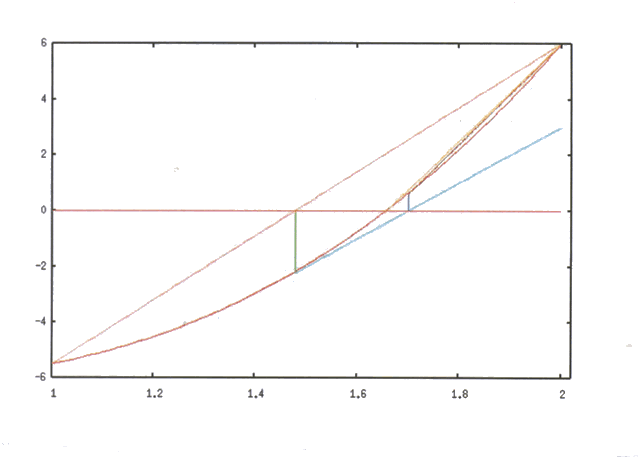
Next: Convergence of secant Method: Up: Main: Previous: False position or Regula
In this method an improvement over Regula Falsi method is
obtained by replacing the secant by straight lines of even-smaller
slope until ![]() falls to the otherside of the zero of
falls to the otherside of the zero of ![]() . The
various steps in the method are given in the algorithm below:
. The
various steps in the method are given in the algorithm below:
Algorithm:
Given a function ![]() continuous on an
interval
continuous on an
interval ![]() satisfying the criteria
satisfying the criteria
![]() , carry out
the following steps to find the root of
, carry out
the following steps to find the root of ![]() of
of ![]() in
in
![]() :
:
(1)Set
![]()
(2) For n=0,1,2...., until convergence criteria is satisfied,
do:
(a) compute
![]()
(b) If
![]() then
then
Set
![]()
Also if
![]() Set
Set ![]()
Otherwise
Set
![]()
Also if
![]() Set
Set ![]()
Example:
Solve
![]() for the root in the
interval [1,2] by Modified Regula Falsi method.
for the root in the
interval [1,2] by Modified Regula Falsi method.
Solution: Since
![]() we go ahead with
finding the root of given function f(x) in [1,2]. Setting
we go ahead with
finding the root of given function f(x) in [1,2]. Setting
![]() and following the above algorithm. Results
are provided in
the table below:
and following the above algorithm. Results
are provided in
the table below:
Modified Regula Falsi Method
| Iteration no. | ||||
| 0 | 1.0000000000 | 2.0000000000 | 1.4782608747 | -2.2348976135 |
| 1 | 1.4782608747 | 2.0000000000 | 1.7010031939 | 0.5908976793 |
| 2 | 1.4782608747 | 1.7010031939 | 1.6544258595 | -0.0793241411 |
| 3 | 1.6544258595 | 1.7010031939 | 1.6599385738 | -0.0022699926 |
| 4 | 1.6599385738 | 1.7010031939 | 1.6602516174 | 0.0021237291 |
| 5 | 1.6599385738 | 1.6602516174 | 1.6601003408 | 0.0000002435 |
The geometric view of the example is provided in the figure below:

Example: Solve
![]() for the root in the
interval [0.5,1.5] by Modified Regula Falsi Method.
for the root in the
interval [0.5,1.5] by Modified Regula Falsi Method.
Modified Regula Falsi Method
| Iteration no. | ||||
| 0 | 0.5000000000 | 1.5000000000 |
0.8773435354 | 2.1035263538 |
| 1 | 0.5000000000 | 0.8773435354 |
0.7222673893 | 0.2828366458 |
| 2 | 0.5000000000 | 0.7222673893 |
0.6871531010 | -0.1967970580 |
| 3 | 0.6871531010 | 0.7222673893 |
0.7015607357 | 0.0026464546 |
| 4 | 0.6871531010 | 0.7015607357 |
0.7013695836 | 0.0000239155 |
| 5 | 0.6871531010 | 0.7013695836 |
0.7013661265 | -0.0000235377 |
| 6 | 0.7013661265 | 0.7013695836 |
0.7013678551 | -0.0000003363 |
Secant Method
Like the Regula Falsi method and the
Bisection method this method also requires two initial estimates
![]() of the root of f(x)=0 but unlike those
earlier methods it gives up the demand of bracketing the root.
Like in the Regula Falsi method, this method too retains the use
of secants throughout while tracking the root of f(x)=0. The
secant joining the points
of the root of f(x)=0 but unlike those
earlier methods it gives up the demand of bracketing the root.
Like in the Regula Falsi method, this method too retains the use
of secants throughout while tracking the root of f(x)=0. The
secant joining the points
![]() is given by
is given by


![$\displaystyle x_{n+1}=\frac{[f(x_{n})x_{n-1}-f(x_{n-1})x_{n}]}{[f(x_{n})-f(x_{n-1})]}$](img127.png)
Example:
Solve
![]() for the root with
for the root with
![]() by secant method to an accuracy of
by secant method to an accuracy of ![]() .
.
Solution:
Set
![]()
![]()
![]()



![]()
![]()
![]() Repeat the
process with
Repeat the
process with
![]() and so on
till you get a
and so on
till you get a ![]() s.t.
s.t.
![]() These
results are tabulated below:
These
results are tabulated below:
| Secant Method | ||||
|---|---|---|---|---|
| Iteration no. |
|
|||
| 0 |
1.0000000000 | 2.0000000000 | 1.4782608747 | -2.2348976135 |
1 |
2.0000000000 | 1.4782608747 | 1.6198574305 | -0.5488323569 |
2 |
1.4782608747 | 1.6198574305 | 1.6659486294 | 0.0824255496 |
| 3 | 1.6198574305 | 1.6659486294 | 1.6599303484 | -0.0023854144 |
| 4 | 1.6659486294 | 1.6599303484 | 1.6600996256 | -0.0000097955 |
Geometrical visualization of the root tracking procedure by Secant method for the above example.
Exercise: Find the solutions accurate to within ![]() for the following problems using Secant's Method.
for the following problems using Secant's Method.
(1) ![]()
(2) ![]()